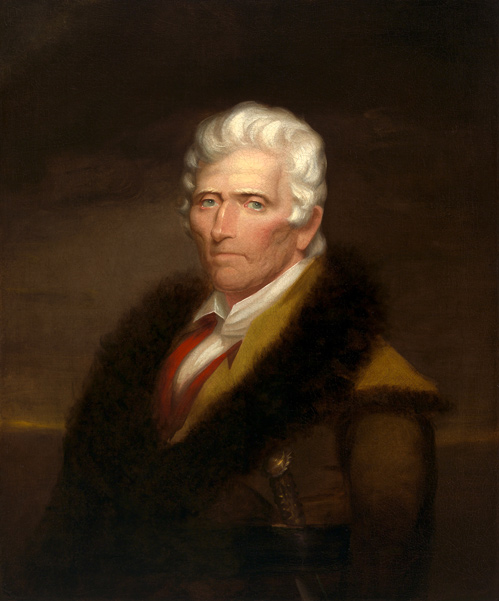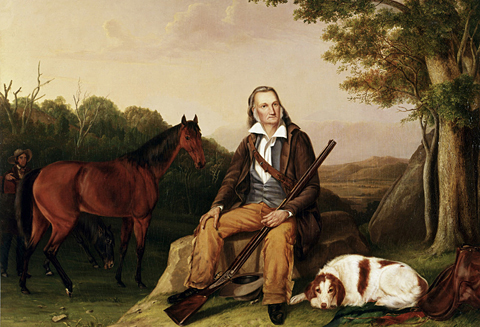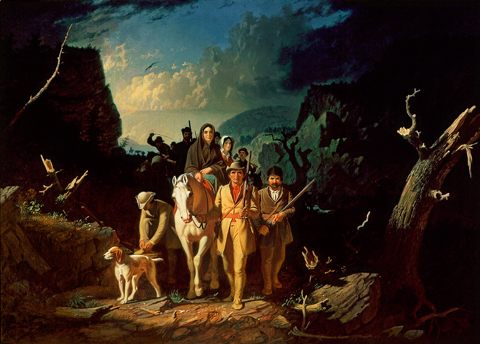Long Hunter
Daniel Boone, 1820
by Chester Harding (1792–1866)
National Portrait Gallery, Smithsonian Institution; partial gift of the William T. Kemper Foundation and of the Chapman Hanson Foundation, https://npg.si.edu/object/npg_NPG.2015.102.
Chester Harding (1792-1866) was a young self-taught itinerant American painter who was commissioned by some of Boone’s St. Louis admirers to paint a portrait of the famous pioneer, then in his eighty-sixth year and living at the home of his daughter, Jemima Boone Callaway. The result was the only life portrait ever made of him. He later produced two full-length images in different attire.
“Everyone thought it good,” his son Nathan recalled, “except that it didn’t show his plump cheeks, a sign of the broad face he had in his robust days.” Nathan also described his father’s appearance, and something of his character. He was “five feet eight inches high and had broad shoulders and chest and tapered down. His usual weight was about 175 pounds, but at one period he exceeded 200 and in his closing years weighed only about 155 pounds. His hair was moderately black, eyes blue, and he had fair skin. He never used tobacco in any form and was temperate in everything.”[1]Neal O. Hammon, ed., My Father, Daniel Boone: The Draper Interviews with Nathan Boone (Lexington: The University Press of Kentucky, 1999), 10-11.
It was Harding who, in a private communication to his family recorded the most famous of Boone’s priceless quips: “I asked him one day just after his description of one of his long hunts,” wrote Harding, “if he never got lost, having no compass. ‘No,’ he said, ‘I can’t say as ever I was lost, but I was bewildered once for three days.'”[2]Hammon, 138, 140.
Daniel Boone was sixty-nine years old in 1803, too old to go traipsing out to the Pacific Ocean with the likes of those twenty-something youths of the Corps of Discovery, even if he had been invited. But Lewis’s “qualifycations” suggest that Boone would have been precisely the kind of hunter he hoped to find. Although he never openly declared that he had found any “Boones,” the journalists clearly tell us that as many as ten of the enlisted men evidently came close, and that there was one who stood out from them all. Who were they, and what skills did they need to develop to achieve that status? To find answers, we need only resort to the journals, as incomplete as they are on the subject of hunting.
Despite the dire threats of perdition and the dour predictions of ruin from critics such as St. John de Crévecur, many frontiersmen turned to hunting in order to supplement the meagre incomes their farms provided. Deer hides and beaver pelts were in high demand on the Atlantic Coast, and that market grew larger each year as urban populations increased. Similar markets in Europe offered even more opportunities for profit. By 1750, however, farm families that had moved into the Piedmont Plateau during the early eighteenth century found that continued pursuit had driven both furbearing and ruminant animals westward beyond the Appalachian Mountains. Market hunters who had once been able to fill their needs within a few days’ travel from their homes had to undertake longer and longer trips to reach prime hunting grounds. In the 1730s and 40s a profitable market hunt could begin in early October and last from a few weeks to several months. By the 1750s a need for change was obvious.
The solution was not far off. In the 1763 Treaty of Paris, which ended the Seven Years War in Europe, ownership of Canada and all of the continent east of the Mississippi was transferred from France to England (except New Orleans, which, along with all of Louisiana, went to Spain, thereby setting up the conditions for the Louisiana Purchase.) At that point, the prospect of hunting on the west slopes of the Appalachians became more appealing because, being British territory, it was ostensibly safer than it had been during the concurrent “French and Indian War.” But there was a catch. Under the terms of that same treaty the Crown acknowledged that all the land west of the Appalachians belonged to the Indians, and promised that European settlers would remain on their own side of the mountains.
Nevertheless, economics, opportunity and a sense of entitlement impelled Piedmont market hunters to accept the risks that accompanied defiance. Frontier families who lived in southwestern Virginia’s Clinch, Holston, and Powell River valleys, as well as the valley of the Yadkin River in western North Carolina, were in the best position to take the lead. The Cumberland Gap, the ancient gateway on the Indian highroad to and from the trans-Appalachian west, was at their doorstep, and a new breed of American hunter-explorer was poised to meet the challenge. They were still hunters who were capable of traveling as far as necessary to find the best—that is, most profitable—hunting grounds. They literally earned their own name: Long Hunters.
Woodsman
He was by no means the first long hunter, nor the only important one, but he was the one who was destined to become, through none of his own doing, the first and most famous American hunter-hero.[3]Ted Franklin Belue, The Hunters of Kentucky: A Narrative History of America’s First Far West, 1750-1792 (Mechanicsburg, Pennsylvania: Stackpole Books, 2003), 87-94, 119-35. Lawrence Elliott, … Continue reading Like young Meriwether Lewis forty-one years later, Daniel Boone (b. 1732) became “habituated to the hunting life” beginning in childhood. At age ten, while helping his mother move their cows to summer pastures, he learned to use a “herdsman’s club” to kill birds and small game, and in the process studied their habits. “When he was twelve or thirteen,” according to his son, Nathan, “his father bought him a gun, and he became a good marksman. The only problem was that he often neglected his herding duties to hunt, but this experience gave him his love of woods and hunting.”[4]Hammon, 10–11. Daniel made his first long hunt during the summer and fall of 1750, accompanied by his boyhood friend, Henry Miller.
They didn’t venture into Indian country beyond the last ridge, but worked their way along the Shenandoah Mountains, hunted and trapped around Big Lick on the Roanoke River, crossed the Blue Ridge Mountains through Roanoke Gap, clambered over the foothills around the Virginia-North Carolina boundary, lugged their hides and furs to market up north in Philadelphia, and finally spent three weeks—and all their profits—on “a general jamboree or frolick” in the city before they headed home. Boone immediately declared hunting as his full-time profession, his “business of life.” And so it was. He didn’t miss a single hunting or trapping season for the next 65 years.
His longest earthly hunt began on 1 May 1769 when he set out from his home on Beaver Creek in the Upper Yadkin River valley of North Carolina accompanied by his brother-in-law John Stewart and three neighbors. With a total of ten or fifteen horses, they headed for Cumberland Gap, the principal gateway to what was then the West, situated today where the common border of Kentucky and Tennessee meet the southwestern tip of Virginia. Once in the western wilderness, their first task was to build a rendezvous and assembly point they called Station Camp, near today’s town of Irvine, on the Kentucky River.
Three of the men in Boone’s party were camp keepers whose jobs included preparing the deer hides for transport to market at the hunt’s end. After making sure a skin was free of all flesh and fat they scraped off the hair and the outer grain, then either salted it to draw out moisture, or allowed it to sun-dry completely. When a skin was dry it was stiff and brittle, and had to be vigorously rubbed across a staking-board until it was soft.[5]Quoted in John Bakeless, Daniel Boone (Harrisburg, Pennsylvania: Stackpole Company, 1939), 413. At that point the “half dressed” skins were subjected to Boone’s or Stewart’s inspection, then packed in fifty-skin, 250-pound bales, each worth at least one hundred dollars. Elk and bison were plentiful, to be sure, but except that their meat was sometimes a welcome relief from venison, their hides were worthless except for the hunters’ own use as tugs or straps, or winter coats.
Risks
The principal risk to every Long Hunter was the threat of capture, torture, and possibly execution by Indians, or at the very least, loss of whatever hides they had on hand, plus their expensive traps and Pennsylvania long rifles. Late in December 1769 a band of Shawnees confronted them, confiscated the hides and furs they had accumulated in the previous eight months, and politely but emphatically ordered Boone and his party back through Cumberland Gap to remind all Colonists to stay out of the Shawnees’ homeland. Indian people were not only angered by the effrontery of the trespass, but disgusted by the Long Hunters’ wastefulness, taking hides but leaving the carcasses to be devoured by scavengers—wolves, magpies, ravens—and the remains cleaned up by maggots.
When Boone got back to camp he found that during his absence his brother Squire had recently arrived from the Yadkin with fresh supplies. Rather than go home as ordered, the Boone brothers and Stewart moved their Station Camp to the vicinity of Blue Lick, Kentucky, about fifty miles to the southwest, and began to rebuild their store of hides and furs. Late in the winter of 1770, while hunting alone, Stewart was killed by Indians. No sign of him was found until five years later, when one of Boone’s crew who was helping to build the Wilderness Road came upon the missing man’s remains and powder horn.
Daniel and Squire were now “in a dangerous, helpless situation, exposed daily to perils and death amongst savages and wild beasts.” His reaction is recorded in John Filson’s flowery turns of phrase, although Boone himself later acknowledged the substance as genuinely his own.
Thus situated, many hundred miles from our families in the howling wilderness, I believe few would have equally enjoyed the happiness we experienced. I often observed to my brother, You see how little nature requires to be satisfied. Felicity, the companion of content, is rather found in our own breasts than in the enjoyment of external things; And I firmly believe it requires but a little philosophy to make a man happy in whatever state he is. This consists in a full resignation to the will of Providence; and a resigned soul finds pleasure in a path strewed with briars and thorns.[6]John Filson, The Discovery, Settlement and present State of Kentucke: and an Essay towards the Topography, and Natural History of that important Country: to which is added an Appendix containing The … Continue reading
That thoughtful descant earned him the reputation as a hunter-philosopher. What is more, the euphonious phrasings of the “autobiography” contrived by John Filson convinced many readers that he was also a gentleman at heart.
Explorations
In the spring of 1770 Squire left Daniel alone in the woods for almost three months while he rode east of the mountains again with a load of furs and brought back more ammunition. Throughout the following summer the brothers hunted deer and half-dressed the skins themselves. In the fall Squire made another trip back east with several packs, while Daniel again remained in the wilderness. To assuage his occasional pangs of loneliness, melancholy and despair he would talk aloud to himself and his three dogs about the “diversities and beauties of nature,” and sing every song he could remember. Squire returned in due time and the brothers continued hunting and trapping. Heading home in March 1771 with several hundred dollars’ worth of beaver pelts, they made their way through Cumberland Gap and descended into the Powell River Valley, where once more, Indians robbed them of all their pelts as well as their guns. In May, with next to nothing to show for more than twenty-four months of hard, dangerous work, Daniel Boone returned to his home on the Upper Yadkin, to his patient wife Rebecca, and to the infant son she had delivered in his absence.[7]John Mack Faragher, Daniel Boone: The Life and Legend of an American Pioneer (New York: Henry Holt and Company, 1992), 28-31, 76-87. The real capital he earned from his odyssey, however, was a more intimate knowledge of a large part of the wilderness tract that in 1792 would become Kentucky, the fifteenth state in the Union.
He had a reputation for remembering every trail he ever walked, and for remembering it whenever and wherever he came upon it again. Whether true or not, that was central to his durable image as a woodsman. It was his legendary skill as a born hunter, however, that dominated the lore that surrounded him well into the 20th century. Like Meriwether Lewis, however, he was decidedly “habituated to the hunting life.” In his own time, it is said, the highest compliment any hunter could desire was to be called “a Boone.”
Throughout his long life he was periodically drawn to other pursuits: farmer, merchant, surveyor, tavern-keeper, land speculator and, out of his idealism and conscientious citizenship, politics and public service. But he never found another viable niche for himself. He was inept as a surveyor; many of his observations and calculations wound up in court. And not one of his hopeful land deals turned out in his favor.
Despite the rigors and dangers of his many long hunts, including several captures by Indians, Boone suffered only two serious accidents in his entire life that we know of. The first occurred in the winter of 1802-03, when he was 68. A beaver trap snapped on one of his hands, and he had to carry it back to camp for help getting it open. Two winters later he got dunked in the Missouri River when the ice broke beneath him; he apparently suffered a severe case of hypothermia.
Moving to Missouri
By the late 1780s the frontier lifestyle in Kentucky was beginning to give way to the basics of statehood, which officially arrived on 1 June 1792, and accounted for the fifteenth star in the flag Lewis and Clark were to carry. It was time for Daniel Boone to find new hunting grounds. Besides, he had become embittered with life in Kentucky, owing to his misfortunes in land speculation. His impulse to move farther westward was soon intensified by auspicious developments in Missouri. In the mid-1790s the Spanish provincial government began encouraging Americans to settle in upper Louisiana to serve as bulwarks against the extension of British immigration and commerce from Canada. Daniel Morgan Boone, the son who had been born during his father’s two-year long hunt of 1769-71, traveled to Missouri in 1797, winding up on the Femme Osage River in the St. Charles District. Upon his father’s request, he made inquiry to the Spanish Lieutenant Governor Zenon Trudeau, who forthwith offered Boone 1,000 arpents tax-free, simply for the cost of surveying them plus the registration fee at New Orleans.[8]An arpent was a French measure of land area that was equal to approximately 0.85 of an acre. Daniel Boone’s 1,000 arpents equalled between 800 and 850 acres. The survey cost him $41 plus the … Continue reading In view of Boone’s fame and wide influence among Americans, Trudeau encouraged him to invite more of his friends to settle west of the Mississippi, for similar grants of land. The elder Daniel and some members of the rest of the extended Boone family followed two years later. Trudeau appointed him syndic (civil judge, over all but capital offenses) and commandant (with both civil and military authority) of the Femme Osage District. As Amos Stoddard pointed out, “these liberal encouragements, the fertility of the lands, and the prospect of mineral riches, in Upper Louisiana, extended the stream of population (hitherto limited to regions on the Ohio) to that country.”[9]Amos Stoddard, Sketches, Historical and Descriptive of Louisiana (Philadelphia: Mathew Carey, 1812; reprint, New York: AMS Press Inc., 1973), 249.
After the U.S. Government assumed authority over Upper Louisiana in 1804, all Spanish land grants had to be reviewed, and most were approved and reconfirmed. Regretably, Boone’s was not, because the Spanish authorities had exempted him from the usual requirement of living on his land. He had to leave the Femme Osage, so he packed up and moved twenty-five miles farther up the Missouri to Nathan Boone’s home at La Charrette. The last of his many hopeful land deals had gone sour.
On 23 May 1804, the Corps of Discovery stopped for an hour at “Boone’s settlement” of “30 or 40 famlys,” where “their was maney people assembled to See us.” The Field brothers had been sent there to buy corn and butter. Considering at least his own brother’s acquaintance with Boone, one would expect Clark at least to have mentioned the famous Kentuckian’s name, but it was only Whitehouse who did so: “This settlement was made by Colonel Daniel Boone, the person who first discover’d Kentucky, & who was residing at this place, with a number of his family and friends.” That sentence occurs only in the fair copy of Whitehouse’s journal, so it may have been inserted by his editor. Boone’s whereabouts on that day evidently cannot be known.
Geographer
Like William Clark, Daniel Boone was a natural geographer. Indeed, the greatest benefit to him of his years as a long hunter was his education in the geography of Kentucky, which he grasped without benefit of a single navigation instrument, not even a compass. Also like Clark, he named many streams and landmarks, thereby identifying places to remember and go back to. On that account he became a highly respected authority on the Kentucky wilderness, and was much sought-after as a consultant, even though he never published a single map. There were more subtle similarities between the two wayfarers, however—in their dealings with Indians, for example. “Clark had always felt at ease with Indians,” writes Landon Jones. “He and his brothers, like Daniel Boone, had adopted many of the Indians’ ways: they dressed like Indians, hunted like Indians, and knew the vocablary and rituals of Indian diplomacy.”[10]Landon Y. Jones, William Clark and the Shaping of the West (New York: Hill and Wang, 2004), 7. The Shawnees at first welcomed Boone as a brother; Clark, “the red-headed chief” as Superintendent of Indian Affairs, was similarly respected by many of the tribes he served. Boone told Alexander Wilson that he survived several captures—three times in all—by showing he was no more afraid of death than any of his captors.[11]John James Audubon, Delineations of American Scenery and Character (New York: G. A. Baker & Company, 1926), 112. He also stroked their egos by allowing them to win shooting contests often enough to confirm their belief that Indians were superior to white men.
Beyond a thin thread of a genealogial connection, there were various functional links between Boone and the Clark family. George Rogers Clark had supported Boone’s Kentucky settlement with his mobile militia. Boone’s son, Nathan, at age twenty-six, was at the head of a company of dragoons that escorted General William Clark up the Missouri to meet with the Osage Indians and begin building Fort Osage. Upon their arrival Clark dispatched Nathan to the Osage villages to summon them to the treaty.
Unlike Clark, who at least kept field notebooks for most of his major travels, Boone never wrote a single page of a travelog. He once dictated a long account of his life to one of his sons, but it was soon lost in a boating accident. Some of the experiences he related to his family were written down, but all those have long since disappeared.
Nevertheless, the wellspring of legends about his life has been virtually inexhaustible. As a popular American hunter-hero and symbol of personal freedom combined with republican citizenship, he has known no equal.
Audubon Remembers Boone
As a young man Daniel was widely respected for the keen eye and steady hand that he showed in the numerous target-shooting contests he won, whether “shooting for the beef” or merely for the right to salvage all the lead embedded in the target. John James Audubon, himself a skillful hunter, remembered another popular proof of marksmanship that Boone once showed him.
Although he became best known on two continents for his beautiful paintings of American birds and quadrupeds, John James Audubon (1785-1851) considered himself essentially a hunter-naturalist (a category of hyphenated hunters in which Meriwether Lewis was among the first). Audubon had at least two different portraits painted of himself with gun, dog, and knapsack. At age eighteen he was already a skilled hunter, spending long hours in the woods with his closest friends and his dog, referring to his solitary, protracted expeditions as “rambles.”
Audubon frequently took part in shooting competitions such as “Driving the Nail.” After hammering a nail about two-thirds of its length into a board hung on a tree, he and his companions would step back forty paces and try to “hit the nail on the head,” driving the rest of its length into the target.
Another hunters’ game was to shoot off the snuff, or burned tip, of a candlewick in the dark of night from a distance of 50 yards without extinguishing the flame or damaging the candle. This was considered good practice for shooting deer or wolves by torchlight, when the only clearly visible parts of the animal that were its eyes. A score of three hits out of seven tries was considered exceptionally good.[12]John James Audubon, “Kentucky Sports,” Ornithological Biography, 294.
Sometime in 1810 Audubon enjoyed a ramble through the woods near Louisville with Boone, who was then in his mid-seventies. The artist described the elderly Kentuckian’s demonstration of how to “bark” squirrels so as not to damage any of the meat:
Boon pointed to one of these animals which had observed us, and was crouched on a branch about fifty paces distant. . . . He raised his piece gradually, until the bead (that being the name given by the Kentuckians to the sight) of the barrel was brought to a line with the spot which he intended to hit. The whip-like report resounded through the woods and along the hills in repeated echoes. Judge of my surprise, when I perceived that the ball had hit the piece of bark immediately beneath the squirrel, and shivered it into splinters, the concussion produced by which had killed the animal and sent it whirling through the air, as if it had been blown up by the explosion of a powder magazine. Boon kept up his firing, and before many hours had elapsed, we had procured as many squirrels as we wished; for you must know, that to load a rifle requires only a moment, and that if it is wiped once after each shot, it will do duty for hours.[13]Francis Hobart Herrick, ed., Delineations of American Scenery and Character (New York: G.A. Baker, 1926), 60-61.
Later, as he became more interested in drawing and painting the wildlife he encountered, Audubon’s gun was as essential as his notebook and pencils, since he had to shoot every bird and quadruped, stuff it and mount it before he could paint it.[14]A few of Audubon’s paintings are reproduced elsewhere on this site: Carolina parakeet, bighorn sheep, hare, mountain beaver (sewelel),and deer. See on this site John James Audubon
Audubon was proud of his long wavy hair, which he customarily dressed with bear grease. On his way to London and Paris in the late 1820s he stopped in Edinburgh to visit friends, who advised him to get a haircut before venturing into the refined circles of urban European society. Having already relinquished his comfortable buckskins and hunting shirt for more modish dress, he regretfully summoned a barber, “and gave up the last vestige of American woodsmanhood.” He arrived in London looking like an ordinary respectable English gentleman, although he took great pride in being referred to there as “The American Woodsman.”[15]Shirley Streshinsky, Audubon: Life and Art in the American Wilderness (Athens: University of Georgia Press, 1998), 207.
The Legend
Daniel Boone Escorting Settlers
through the Cumberland Gap, 1851-52
George Caleb Bingham (1811-1879)
Mildred Lane Kemper Art Museum, Washington University in St. Louis. Oil on canvas, 36-1/2 x 50-1/4 inches, Mildred Lane Kemper Art Museum. Washington University in St. Louis, Gift of Nathaniel Phillips, 1890.
In this painting, executed more than three-quarters of a century after the event it commemorates, George Caleb Bingham evoked the spirit of a crucial moment not only in Daniel Boone’s life but also in American history. Late in the summer of 1775, the forty-one-year-old pioneer led his family and more than forty of their friends through the gloom of Cumberland Gap toward their new homes in the Kentucky wilderness.
The patriarchal Boone, in buckskins, moccasins and a Quaker-style beaver-felt hat, strides with dignity and self-assurance between the “cliffs . . . so wild and horrid, that it is impossible to behold them without terror,”[16]Filson, The Adventures of Colonel Daniel Boone, 2. into the warm light and bright hope of the trans-Appalachian West. He leads a symbolic white horse[17]See, for example, Revelations 19:11, 14. bearing his wife Rebecca, who resembles a Madonna by Raphael. Behind her is their daughter Jemima. They would, Boone boasted, be the first two women to stand on the banks of the Kentucky River. To underscore the implications of their presence Bingham added, as a subtitle, the dedication “To the Mothers and Daughters of the West.” Jemima’s future husband, Flanders Callaway, is at Boone’s left.
Thus far, the scene evokes the combination of a Biblical flight into Egypt and a sally toward the promised land. It is an apt comparison. Their destination was Boonsborough, the riverside settlement that Boone had recently established 300 miles into the unspoiled Kentucky wilderness from their homes on North Carolina’s Yadkin River.
At Boone’s far right, the young man bending to adjust a moccasin is believed to represent his oldest son James, as a gesture of memorial by the artist. James was tortured and killed by a party of Lenape Delaware Indians who foiled his father’s first attempt, in 1773, to lead his family and friends through Cumberland Gap to a new home in Cherokee country.
Reproduced countless times in engravings and lithographs throughout the second half of the nineteenth century, Bingham’s painting did more, perhaps, than any other single literary or artistic monument to Daniel Boone to consolidate the hunter-explorer’s place in popular American history.[18]E. Maurice Bloch, George Caleb Bingham: The Evolution of an Artist (Berkeley: University of California Press, 1967), 120-137.
In mid-November of 1806 Meriwether Lewis led a small group of expedition veterans eastward over Boone’s Wilderness Road on a triumphal return from what was soon to be accepted as a major part of the Far West. With them were the Mandan Chief Sheheke (Big White) and Yellow Corn, who had eagerly accompanied them to meet President Jefferson at Washington City. They passed through Cumberland Gap a mere thirty-one years after Daniel Boone had led the way through it into the region that is now thought of as the First American West.
Moving On
Sunset fell slowly on the Kentucky long hunters after the Revolutionary War. By the turn of the new century that vanguard, and the settlers who followed them, had fulfilled their destinies east of the Mississippi. By 1820 there were no bison left on the Old Frontier, and even the hardy deers’ numbers had been significantly reduced. Other uniquely American entrepreneurs, the mountain men and fur trappers, were to take up the long hunters’ mantle, and in turn give way to the market hunters who, by the end of the 1880s, nearly extirpated all the bison from North America, at the close of America’s last western frontier. By that time the hunting grounds were virtually empty, and there was no place else to go. But the man credited with first showing the way was still alive in American popular history—Daniel Boone, the great still hunter, long hunter, explorer, pioneer, and legend.
On 18 March 1813, Boone’s devoted wife, Rebecca, died, at age seventy-three. Her husband’s last earthly long hunt was in the winter of 1815-16, when he departed from his son Nathan’s home at Charrette Creek and arrived at Fort Osage, 140 miles up the Missouri, in April. He wanted to make an even longer journey the following year—to the Rockies and “the Salt mountains, lakes and ponds”[19]Precisely what he meant by “Salt mountains” is a mystery. He believed that “the Salt Mountain is but five or six hundred miles west of [Fort Osage],” which would have meant … Continue reading—but illness demolished that dream.[20]Faragher, 314-15. In 1817, at age 83, he tried a short hunt with his seventeen-year-old grandson James, but that too was shortened by his frailties. At Nathan’s home on Femme Osage Creek, on 26 September 1820, near the beginning of a new deer-hunting season, eighty-six-year-old Daniel Boone finally set out, alone, on the longest hunt of all.
Related Pages
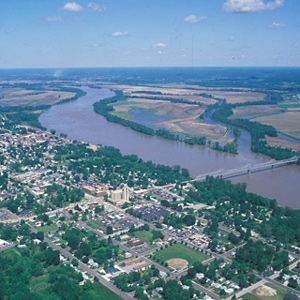

On 25 May 1804, about forty river-miles above St. Charles, the expedition camped near a small village at the mouth of a creek called Charrette. Its seven French families had arrived only a few years before. The family of Daniel Boone moved there sometime after 1804.
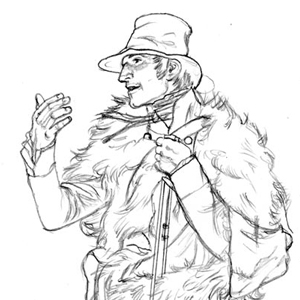

Colter left a legacy of western lore, not the least of which was his famous run from the Blackfeet Indians and his exploration of “Colter’s Hell.” Yet his contributions to the expedition were also many.
September 24, 1803
Drying out
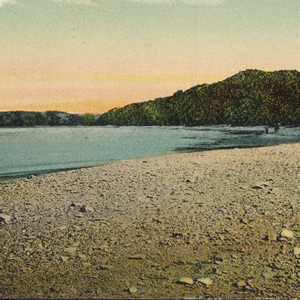

Near Maysville, KY At Maysville, John Colter likely asked to join the expedition. Ten days later, fellow traveler Thomas Rodney describes the town and a boat being built there. He also expresses his low opinion of Ohio River settlers.
Notes
| ↑1 | Neal O. Hammon, ed., My Father, Daniel Boone: The Draper Interviews with Nathan Boone (Lexington: The University Press of Kentucky, 1999), 10-11. |
|---|---|
| ↑2 | Hammon, 138, 140. |
| ↑3 | Ted Franklin Belue, The Hunters of Kentucky: A Narrative History of America’s First Far West, 1750-1792 (Mechanicsburg, Pennsylvania: Stackpole Books, 2003), 87-94, 119-35. Lawrence Elliott, The Long Hunter: A New Life of Daniel Boone (New York: Reader’s Digest Press, 1976). Emory L. Hamilton, “The Long Hunters,” Historical sketches of Southwest Virginia, Publication 5 (March 1970). Online at http://www.rootsweb.com/~vawise2/sketches/HSpubl35.html. Accessed 29 November 2007. |
| ↑4 | Hammon, 10–11. |
| ↑5 | Quoted in John Bakeless, Daniel Boone (Harrisburg, Pennsylvania: Stackpole Company, 1939), 413. |
| ↑6 | John Filson, The Discovery, Settlement and present State of Kentucke: and an Essay towards the Topography, and Natural History of that important Country: to which is added an Appendix containing The Adventures of Col. Daniel Boon, of the first Settlers, comprehending every important Occurrence in the political History of that Province (Wilmington, Delaware: Printed by James Adams, 1784), 42. Online Eletronic Text Edition, ed. by Paul Royster, (Electronic Texts in American Studies, Libraries at University of Nebraska-Lincoln, 2006) p. 24. Filson’s version of Boone’s story covered only the years from May 1768 to October of 1782. It was first published in Mathew Carey’s American Museum magazine, Volume II (1787), then as part of Filson’s book, and again by George Imlay in 1793. |
| ↑7 | John Mack Faragher, Daniel Boone: The Life and Legend of an American Pioneer (New York: Henry Holt and Company, 1992), 28-31, 76-87. |
| ↑8 | An arpent was a French measure of land area that was equal to approximately 0.85 of an acre. Daniel Boone’s 1,000 arpents equalled between 800 and 850 acres. The survey cost him $41 plus the chainmens’ fees. |
| ↑9 | Amos Stoddard, Sketches, Historical and Descriptive of Louisiana (Philadelphia: Mathew Carey, 1812; reprint, New York: AMS Press Inc., 1973), 249. |
| ↑10 | Landon Y. Jones, William Clark and the Shaping of the West (New York: Hill and Wang, 2004), 7. |
| ↑11 | John James Audubon, Delineations of American Scenery and Character (New York: G. A. Baker & Company, 1926), 112. |
| ↑12 | John James Audubon, “Kentucky Sports,” Ornithological Biography, 294. |
| ↑13 | Francis Hobart Herrick, ed., Delineations of American Scenery and Character (New York: G.A. Baker, 1926), 60-61. |
| ↑14 | A few of Audubon’s paintings are reproduced elsewhere on this site: Carolina parakeet, bighorn sheep, hare, mountain beaver (sewelel),and deer. See on this site John James Audubon |
| ↑15 | Shirley Streshinsky, Audubon: Life and Art in the American Wilderness (Athens: University of Georgia Press, 1998), 207. |
| ↑16 | Filson, The Adventures of Colonel Daniel Boone, 2. |
| ↑17 | See, for example, Revelations 19:11, 14. |
| ↑18 | E. Maurice Bloch, George Caleb Bingham: The Evolution of an Artist (Berkeley: University of California Press, 1967), 120-137. |
| ↑19 | Precisely what he meant by “Salt mountains” is a mystery. He believed that “the Salt Mountain is but five or six hundred miles west of [Fort Osage],” which would have meant somewhere between the Platte River and Floyd’s River. Perhaps he, the subject of so many legends, tall tales, and fantasies, was equally susceptible to similar delusions, like the one about the mountain of salt 1000 miles up the Missouri, which had seduced Thomas Jefferson‘s gullibility. |
| ↑20 | Faragher, 314-15. |
